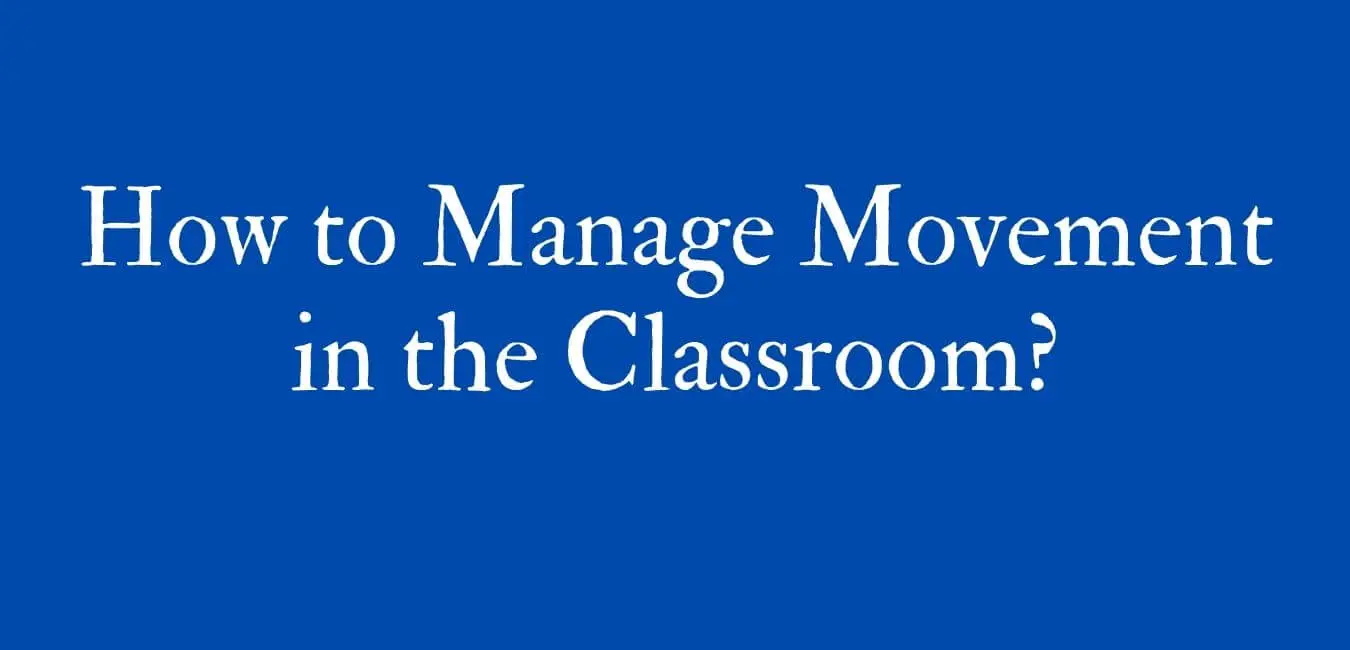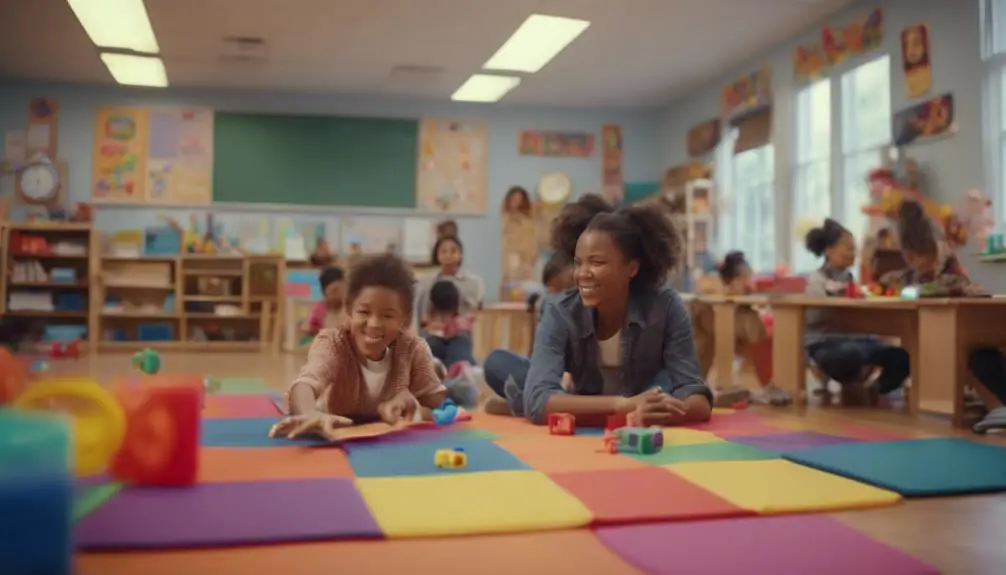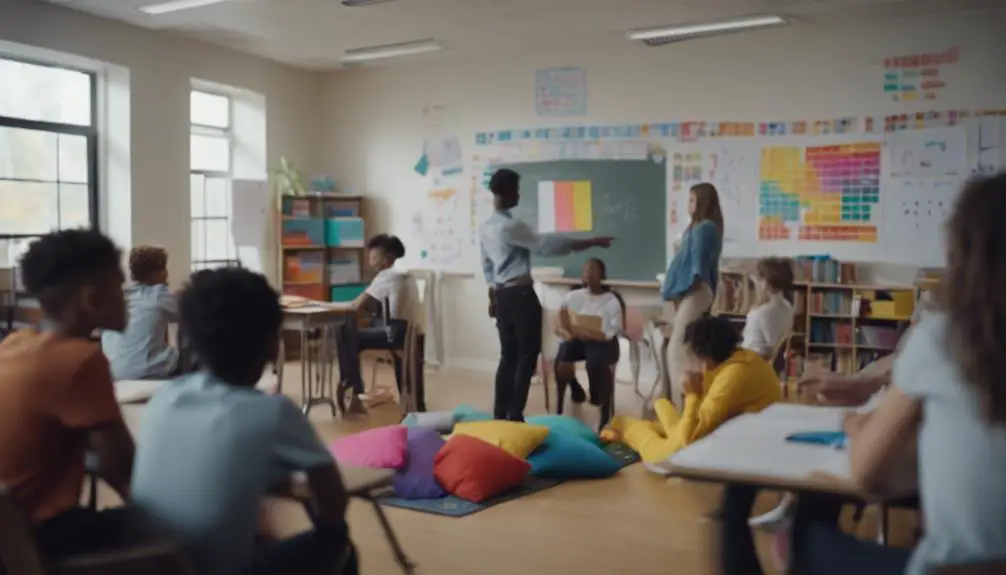In order for students to learn, they need to be able to move around. However, in order for them to stay on task, it is important to have a plan for managing movement in the classroom.
There are some ways to manage movement in the classroom. One way is to have specific times when students are allowed to move, such as during independent work time or during break time. Another way is to allow students to move around as long as they are quiet and are not disturbing other students. A third way is to have a designated space in the classroom where students can go to move around, such as a play area or a yoga mat.
In this article, I will discuss some strategies to help you manage movement in the classroom. I will also explore some benefits of movement in the classroom. If you are ready, let’s get started!
The Importance of Movement in the Classroom
From my experience, the following are some of the reasons why you may consider incorporating movement into your classroom:
1. Improved Focus:
Movement is an important part of the classroom environment. It helps students focus and pay attention (Mullins et al, 2019). When students engage in movement activities, their minds become active, and they are able to learn more effectively.
There are many ways to incorporate movement into the classroom. Due to long hours of sitting and working, having students get up and move around every 30 minutes or so can help a lot. This helps them stay alert and focused.
Another tip is to use active learning strategies such as problem-solving activities and hands-on experiments, that demand movement.
In the nutshell, movement helps students relieve stress and stay calm. Students who are stressed out or anxious often have a hard time focusing on class. If a student is having trouble focusing, it may be helpful to take a break and go for a walk outside or do some deep breathing exercises.
2. Increased Learning:
Movement is essential for human development and functioning. It is no wonder that movement is also crucial for learning. Movement not only allows students to get the blood flowing to their brains, but it also allows them to explore their environment and interact with others. Movement enhances physical health, cognitive function, and academic achievement (Stevens-Smith, 2004).
One study found that first-graders who spent more time in physical activity achieved better reading scores than those who did not (Alverez-Bueno, 2017). In another study, researchers looked at the relationship between movement and learning in elementary school children. They found that children who were physically active were more engaged than their counterparts in nonmovement-based classes (Lindt and Miller, 2017).
There are several reasons why the movement promotes increased learning in students. First, when students are moving, they get more oxygen to their brains. This increased oxygen flow helps improve cognitive function and memory.
3. Enhanced Creativity:
Enhanced creativity in students is something that educators strive to achieve in the classroom. It is important for students to be able to think critically and come up with innovative ideas. While there are many factors that contribute to enhanced creativity, movement is one aspect that often goes overlooked.
When students are given the opportunity to move around, their brains are able to function more effectively. Movement helps to improve blood circulation and increases oxygen flow to the brain. This allows for students to think more clearly and come up with new ideas. In addition, movement releases endorphins which help improve moods and increase energy levels.
Teachers can incorporate movement into their lessons in a variety of ways. For example, teachers can have students get up and walk around the room while they are working on a project or have them stand up and move around while they are listening to a lecture.
4. Reduced Stress:
In our fast-paced society, it’s no surprise that students often feel stressed. And when students feel stressed, they can have a hard time focusing on the classroom. Fortunately, there are ways to reduce students’ stress. One way is to promote movement in the classroom.
Movement can help reduce students’ stress in a few ways. First, it can distract them from their worries and help them focus on the task at hand. Second, it can release tension and help kids feel more relaxed. And finally, movement can provide a sense of accomplishment and boost feelings of self-confidence.
So, how can teachers promote movement in the classroom? There are lots of options! Teachers can have kids get up and move around every few minutes, or they can have them do some kind of physical activity during class.
Check out our other posts here.
5. Improved Physical Health:
Movement is an important part of a child’s day and has many benefits for their physical health. When children are given the opportunity to move throughout the day, they experience improved physical health. Movement helps to increase heart rate and blood flow, which in turn delivers more oxygen and nutrients to the brain. This improved blood flow can help to improve cognitive function, focus, and attention span.
Additionally, movement helps to increase strength, flexibility, and endurance. Students who move more often are also less likely to be overweight or obese, which can lead to a variety of health problems later in life.
How to Manage Movement in Your Classroom
The following tips and strategies can help you handle student movement in your classroom:
1. Establishing classroom routines
Classroom routines are an important part of a teacher’s toolkit. They help manage movement in the classroom and can make the start of the school day more predictable for students. There are a few key things to keep in mind when establishing routines:
a. Begin by identifying what is important to you and your students. What do you want them to do when they first enter the classroom? What behaviors do you want to see throughout the day?
b. Be clear with your expectations. When students know what is expected of them, they are less likely to engage in disruptive behavior.
c. Keep your routines consistent. Whether you use a visual timer or chant a specific rhyme each morning, it’s important that your students know what is coming next. This will help them feel more comfortable and secure in the classroom setting.
Check here for more information on how to create classroom routines and procedures.
2. Designating specific times for movement
Movement is essential for students’ physical and mental health, yet many teachers struggle to find the time for movement in their classrooms. Designating specific times for movement can help manage movement in your classroom and ensure that all students have an opportunity to move throughout the day.
Here are a few suggestions for how to designate specific times for movement in your classroom:
a. Start and end each class with a movement break. This is a great way to wake up your students and get them moving at the beginning of class, and it also provides a chance for them to stretch out their muscles after sitting for a long period of time.
b. Incorporate movement breaks into your lesson plans. This can be as simple as having students stand up and move around while they are listening to a lesson.
c. Keep movement breaks brief. If you have students walking around the room, make sure they are only moving for five to ten minutes at a time. You don’t want them to get tired out if they have to walk around the room a lot.
d. Use dance breaks. This is a great way to incorporate movement into your lesson plans while also getting students excited about it. Dance breaks can be a fun way to break up the monotony in your classroom, and they are also a great way for students to get some exercise.
e. Keep the lesson short. If you are using dance breaks, try to keep them under ten minutes long. Longer dance breaks can lead to fatigue and burnout, so make sure your lessons are brief and don’t go on too long.
3. Providing opportunities for physical activity.
Give your students some opportunities to engage in physical activities in your classroom. You can do this in a variety of ways.
There are many different types of dance breaks that can be used during the day. Try to incorporate at least one dance break into your lesson plans each week. If you are using dance breaks during class, vary the length and make sure the break is at least ten minutes long.
Some possibilities for dance breaks include:
Some of these activities can be used to help students deal with frustration, emotions, and boredom. Students can participate in a variety of physical activities during the school day. Even though students have many options for being active, it is important to make sure that these opportunities are not disruptive to the class or distracting from instruction. Dance breaks need to be planned in advance and be used as a part of the lesson plan. It is important that dance breaks occur regularly. Students should not wait until they are bored or frustrated to do something physical.
4. Reward appropriate behavior:
In order to manage movement in the classroom, it is important to reward appropriate behavior. When students follow the classroom expectations for movement, they should be praised and rewarded. This helps to reinforce positive behavior and discourage negative behavior. Appropriate rewards could include verbal praise, a sticker chart, or a small prize.
When students are not following the expectations for movement, it is important to provide them with feedback. This feedback should be clear and concise and should help the student understand what they need to do to correct their behavior. If a student continues to exhibit inappropriate behavior, it is important to take disciplinary action.
5. Model appropriate behavior:
When managing movement in the classroom, modeling appropriate behavior is one of the most effective tools a teacher has. By demonstrating how to behave in a way that is respectful and conducive to learning, the teacher can set the tone for the class and reduce disruptions. In addition, when students see their teacher behaving appropriately, they are more likely to follow suit.
There are many ways to model appropriate behavior in the classroom. One key strategy is to be aware of your own movements. Avoid fidgeting or making excessive noise, and instead, use purposeful movements that illustrate how to stay on task. Make eye contact with students when you speak to them, and keep your voice at a moderate level. Be aware of your body language as well; standing tall with open gestures can help convey a message of respect.
It’s also important to be proactive in managing student behavior.
6. Use verbal prompts and cues:
When you’re teaching, movement in the classroom is inevitable. However, there are ways to help manage movement and keep students on track. Verbal prompts and cues are one way to do this.
Verbal prompts are short phrases or sentences that you say to students to get them started on a task or remind them of what they should be doing. Cues are similar, but they involve physical gestures or motions. Both verbal prompts and cues can be used to help manage movement in the classroom by getting students up and moving around when they need to move and keeping them focused on their work when they need to stay seated.
There are a few different types of verbal prompts and cues that you can use in your classroom: starting cues, stopping cues, transition cues, and task-specific cues.
7. Create a designated space for movement:
One way to help manage movement in the classroom is to create a designated space for movement. This can be a specific area in the room or outside, depending on your setup and teaching style. Having a designated space for movement helps students know where they are allowed to move and helps keep them organized. It can also help to manage noise levels and distractions.
When creating a designated space for movement, be sure to consider the needs of your students. If you have a large class, you may need more than one area for movement. You may also want to consider including areas for different types of movement, such as quiet reading or active play.
Including a designated space for movement in your classroom can help improve student behavior and focus. It can also help keep students active and healthy, which is especially important during long school days.
8. Be aware of your students’ needs:
In order to effectively manage movement in the classroom, it is important to be aware of your student’s individual needs. Some students may need to move around to stay focused, while others may need to move in order to calm down. If you are aware of these individual needs, it will be easier for you to manage movement in the class.
For example, if you notice that a student is constantly getting up out of his seat, you can provide him with a fidget toy or allow him to take a short break outside of the classroom. Alternatively, if you notice that a student is becoming agitated and disruptive, you can provide her with a calming activity such as coloring or writing in a journal.
By being aware of your students’ individual needs, you can help them stay focused and calm in the classroom.
9. Keep your classroom organized:
When your classroom is organized, it helps you manage movement in the class. With everything in its place, students know where to go and what to do when they enter the room. This reduces chaos and allows for more focused learning.
One way to help keep your classroom organized is to create designated areas for different activities. For example, have a section for working on projects, a reading corner, and a place for playing games. This will help students stay focused when they are working on tasks and avoid distractions.
Another way to keep your classroom organized is by using labels. Labeling bins, shelves, and cubbies make it easy for students to know where to put things back when they are finished with them. This also eliminates the need for constant reminders about where things belong.
10. Have a plan for how you will manage movement in your classroom.
One way to manage movement is to have a plan for how you will manage it. This plan should include specific times when students are allowed to move around and specific tasks they are allowed to do while they are moving. It is also important to make sure that everyone in the class knows the plan and follows it consistently.
Another way to manage movement is to establish rules for how students should move around the classroom. For example, students may be asked not to run or walk too close to other students.
One of the most important things you can do to manage movement in your classroom is to have a plan. A plan will help you anticipate how much movement will be necessary and when it will happen. It can also help you prepare for how you will manage movement in your classroom. Having a plan also helps to keep students on task by providing them with predictability.
There are a number of ways to manage movement in your classroom. You may want to have students move around the room or outside, use brain breaks, allow for free choice time, or have specific times for movement throughout the day. It’s important to consider what will work best for your students and what you are comfortable with.
No matter what type of plan you choose, it’s important that you are clear with your students about what is expected of them.
11. Be consistent with your rules and expectations.
One of the most important things you can do to manage movement in your classroom is to be consistent with your rules and expectations. If you allow students to move around one day, but not the next, they won’t know what is expected of them and will likely become frustrated. This can lead to disruptions in the class and make it difficult for students to focus.
It’s important to have a plan for how you want students to move in your classroom and stick to it. You may want them to walk around quietly or stay in their seats unless they are getting up for a restroom break or water. Whatever your expectations are, make sure you enforce them consistently.
Students will also appreciate knowing what is expected of them. When they know the rules, they can follow them more easily and feel more comfortable in the classroom.
Conclusion
Movement is an important part of any day, especially for young students. It helps them focus, learn, and stay healthy. However, managing movement in the classroom can be a challenge. The tips recommended in this article can help you manage movement effectively for improved teaching and learning.
Related Posts:


















